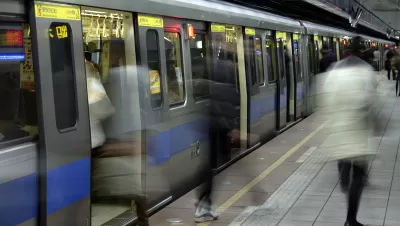The effects of a global pandemic on American shores are beginning to emerge for public transit systems. The consequences of a drop in transit ridership could extend beyond the end of the pandemic.

On March 9, Toronto Public Health officials released an announcement assuring residents that was safe to use public transit amidst the coronavirus scare, reports Ben Spurr. The announcement responded to a far less assuring announcement, made the day before by Governor Andre Cuomo and Mayor Bill De Blasio, suggesting residents of New York City should avoid public transit to help prevent the spread of the coronavirus.
COVID-19 hit close to home for the New York Port Authority—Rick Cotton, the executive director of the Port Authority of New York and New Jersey, is one of the confirmed cases in the pandemic.
Last week, expectations about how coronavirus would impact public transit relied on experience from Asian countries, but following the announcement about Cotton and the statements of New York's political leadership, U.S. transit systems began to feel the effects. Transit ridership dropped by 170,000 passengers—8 percent—on BART between the last week of February and the first week of March, according to an article by Rachel Swan. [Update: Reports now reveal ridership on the New York MTA system dropped 18.5% on Wednesday, March 11 relative to the comparable day in 2019—a total of 996,000 riders.]
As pointed out in an article by Aaron Gordon, decreased transit ridership could have a long-term impact of transit funding, and not just because of a reduced amount of fares being paid by riders as they work from home and avoid public gatherings that tend to drive transit ridership (as driving is additionally incentivized by plummeting oil prices).
On average, 56 percent of a transit agency’s budget comes from state or local subsidies, according to that same Department of Transportation report—the rest comes from the federal government or is directly generated by the agency through advertising or other initiatives—and a big part of convincing politicians those subsidies are worthwhile is by demonstrating people use the system with, you guessed it, ridership figures.
So, if ridership plummets, that argument becomes harder, especially if government budgets become stressed bailing out all the other at-risk businesses and populations that need more money. When it comes to governments at all levels, transit has a long history of taking the back seat during crunch time. And if people abandon it in droves due to coronavirus, history may repeat itself once again.
FULL STORY: Coronavirus May Have a Lasting Impact on Public Transit Funding

Planetizen Federal Action Tracker
A weekly monitor of how Trump’s orders and actions are impacting planners and planning in America.

Congressman Proposes Bill to Rename DC Metro “Trump Train”
The Make Autorail Great Again Act would withhold federal funding to the system until the Washington Metropolitan Area Transit Authority (WMATA), rebrands as the Washington Metropolitan Authority for Greater Access (WMAGA).

The Simple Legislative Tool Transforming Vacant Downtowns
In California, Michigan and Georgia, an easy win is bringing dollars — and delight — back to city centers.

The States Losing Rural Delivery Rooms at an Alarming Pace
In some states, as few as 9% of rural hospitals still deliver babies. As a result, rising pre-term births, no adequate pre-term care and harrowing close calls are a growing reality.

The Small South Asian Republic Going all in on EVs
Thanks to one simple policy change less than five years ago, 65% of new cars in this Himalayan country are now electric.

DC Backpedals on Bike Lane Protection, Swaps Barriers for Paint
Citing aesthetic concerns, the city is removing the concrete barriers and flexposts that once separated Arizona Avenue cyclists from motor vehicles.
Urban Design for Planners 1: Software Tools
This six-course series explores essential urban design concepts using open source software and equips planners with the tools they need to participate fully in the urban design process.
Planning for Universal Design
Learn the tools for implementing Universal Design in planning regulations.
Smith Gee Studio
City of Charlotte
City of Camden Redevelopment Agency
City of Astoria
Transportation Research & Education Center (TREC) at Portland State University
US High Speed Rail Association
City of Camden Redevelopment Agency
Municipality of Princeton (NJ)





























